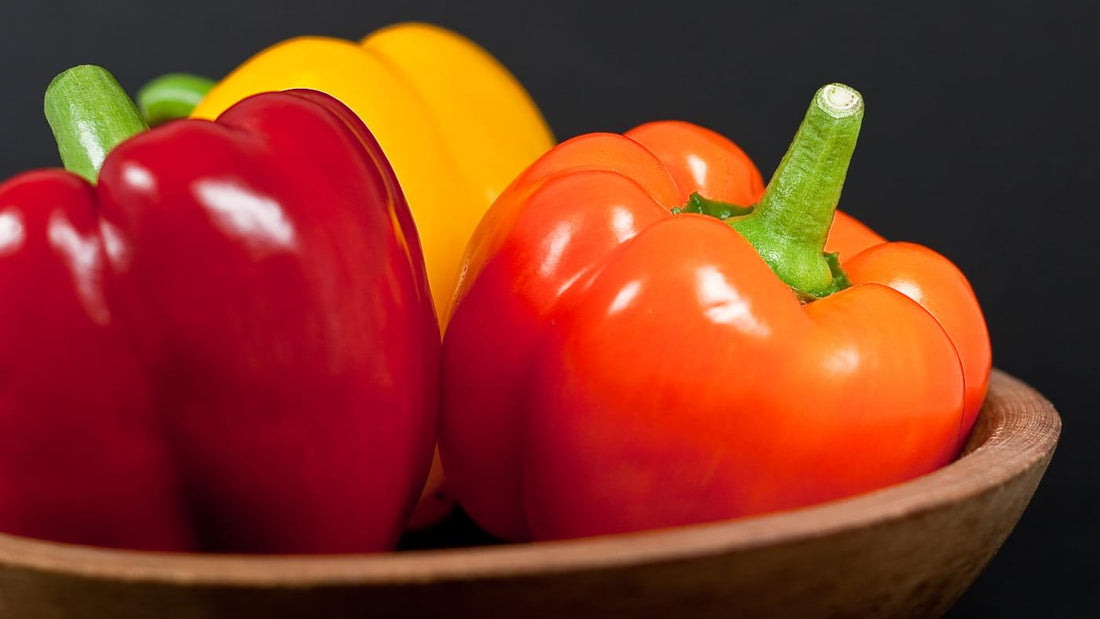Originally called “pimiento”, but subsequently named “bell pepper” by European colonizers of North America for its bell shape, this vegetable can grow in a wide variety of climates and conditions, making it one of the most consumed foods around the world.
In 1493, Christopher Columbus led an expedition through Central and South America to find peppercorns but came across bell peppers instead. After taking bell pepper seeds back to Spain, the plant spread throughout Europe and Asia like wildfire!
From that point on, bell pepper and paprika—a product of dried, ground bell peppers—has become a staple in the cuisines of Brazil, Mexico, China, Turkey, Indonesia, Vietnam, Spain, Portugal, France, and the US—just to name a few.

Despite their unique design, bell peppers, potatoes, tomatoes, and eggplants are all part of the same family—the nightshade family. What makes food in this family special is their high antioxidant content that strengthens cells and reduces risk of cancer, diabetes, and infection.
But, like every family, the nightshade family isn’t perfect. These foods contain small amounts of the chemical compound solanine. When eaten in massive amounts, solanine can cause diarrhea, headache, and fever. As nightshade plants rot, the amount of solanine they contain builds up.
That’s why eating green potatoes, brown tomatoes, wrinkled bell peppers, and other rotting foods can make you sick.

But, when ripe, this might just be the most colorful vegetable on the food pyramid. Different varieties of bell peppers start out green on the vine, but turn yellow, orange, or red as they ripen. Other varieties are bred to stay green throughout their growth cycle. Some varieties even turn white, brown, black, and purple!
Bell peppers don’t have the reputation of being a superfood because of their color, though; these peppers are filled to the stem with amazing health benefits that you don’t want to miss out on.
The Top Health Benefits of Bell Peppers

Bell peppers lower blood pressure
This vegetable is an amazing source of vitamin C. Just one cup of chopped bell pepper contains about 120 milligrams of vitamin C, fulfilling an adult’s daily dietary needs.
Vitamin C is important for numerous bodily functions including healing wounds, bone and teeth maintenance, and the growth, development, and repair of body tissues. This vitamin is also key to controlling blood pressure.

By ridding your body of excess fluids, vitamin C reduces the pressure within your blood vessels, lowering your blood pressure and decreasing your chances of heart attack, stroke, and heart failure.
Bell peppers improve your eye health
Thanks to bell peppers’ high carotenoid content, adding them to your daily diet can reduce your risk of visual impairments, as well as cataracts and macular degeneration.
Carotenoids are antioxidants found in dozens of foods. They are almost always associated with foods that are brightly colored—especially those with an orange pigment. Squash, pumpkin, corn, egg yolks, carrots, sweet potatoes, papaya, cantaloupe, and bell peppers are all great sources of carotenoids—and all fall on the yellow/orange color spectrum.

Besides improving your eye health, the carotenoids in these foods can improve your cardiovascular health and lower your risk of cancer.
Bell peppers support healthy digestion
Bell peppers are full of dietary fiber that helps your body regulate blood sugar and hunger levels. Since fiber can’t be broken down into sugar molecules by the body, it passes through you without being digested.
As it moves through your intestines, fiber cleans out your gut and helps prevent constipation and diarrhea. In short, fiber is your digestive system’s best friend.
Increased fiber intake is also linked to better cardiovascular health, and a reduced risk of type 2 diabetes and cancer. You can get all these amazing benefits from bell pepper—just one cup of raw bell pepper contains 2.5 grams of dietary fiber.
Buying Bell Peppers: What to Look For

Bell peppers are in season year-round due to their mass production in countries all around the world. In the US, California and Florida are the largest producers of bell peppers. They’re shipped to every state no matter the month. However, bell peppers peak in quality during the summer season from July to September.
If you want the best bell peppers no matter where or when you purchase them, there are a few things you can look out for.
First, look at the peppers’ skin. The best bell peppers will have a vivid color and taut, thick, blemish-free skin. Any brown or wrinkled areas on a pepper is a sign that it is past its optimal stage of ripeness.
Second, look at the stem. If the stem is decaying, brown, or damaged, this is another sign that the pepper may be overly ripe. A damaged stem may also be a sign that the pepper will be too dry.

You can discover even more about a bell pepper by picking it up. When you squeeze a bell pepper, its walls should be firm enough to withstand the pressure—yielding only slightly. It should also feel heavy for its size. This tells you that the pepper is well hydrated and ready for cooking.
Cooking with Bell Peppers

Before you can eat a bell pepper, it must be prepared. This should only take you a few seconds once you get the hang of it.
Wash your pepper first. Warm water can reduce the pepper’s antioxidant content, so make sure to use cold water only. If the pepper is waxed, you’ll have to gently go over it with a scrub brush.
Then, using a paring knife, cut into the pepper, making a circle around the stem. Once you pull the stem out, cut the pepper in half and from top to bottom and clean out the seeds. Don’t do this until you’re ready to start cooking, though—once a pepper is cut and the stem is taken off, its ripening process will speed up, leaving the pepper withered and dry.
Once prepared, you’re ready to start cooking!
There are so many delicious recipes that can be enhanced with this aromatic vegetable. Bell peppers go great in chilis, on pizza, in sandwiches, burritos, and fajitas, and are the perfect addition to any salad. Bell peppers also taste great stuffed.

Whatever meal you choose to add this superfood to, you’ll get the most health benefits by eating it raw or by sauteing it. Simply put some oil into a pan and cook the pepper until browned. You can add onions and garlic to the pan, too, for an extra kick of flavor.

